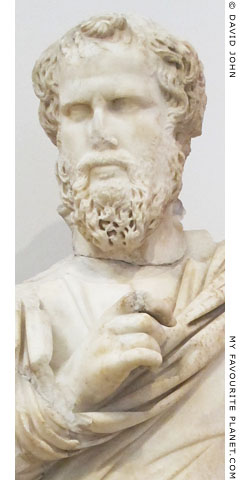The Library of Celsus
3. Inside the library
Today the interior of the library does not look quite as splendid as the facade, and the walls of the back and sides are of brick and undecorated stone rather than marble. The back of the facade which comprises the east wall of the interior, as restored, is quite plain (see photo below). It is surprisingly small, a single room measuring only 16.72 by 10.92 metres, with no adjoining rooms. However, there were originally two upper galleries running right around the walls of the room. Some of the bases of the columns which supported the galleries can still be seen.
It has been estimated that the wooden shelving cabinets which once stood in the niches in the walls held as many as 12,000 books, mostly in the form of papyrus rolls.
The room was presumably also luxuriously designed, with decorated walls, furniture, statues and perhaps paintings. In the apse in the far (west) wall of the library (on the right in the photo above) once stood a statue, perhaps of Athena (as in the Library of Pergamon), Apollo, a Roman emperor or even Celsus himself.
<>In an attempt to make the space more interesting for visitors, various information boards (in Turkish and German, with some copies of Ancient Greek and Latin inscriptions, see gallery page 30) have been set up inform visitors what would have been here if most of it had not been destroyed over the centuries or carried off to various museums.
The relatively small area taken up by the library is due to the fact that it was constructed between earlier buildings and monuments such as the neighbouring Gate of Mazeus and Mithridates.
The apparently disproportionate grandeur of the facade, on the other hand, can be explained by the fact that it was built as a heroon (mausoleum [1]) for Celsus (see gallery page 30), where he would be honoured as a hero. The most important object inside is the tomb and sarcophagus of Celsus, which is in a basement chamber below the apse, accessed by a narrow corridor entered from outside the north wall. Unfortunately this is not open to the public.
The sarcophagus, 2.68 m long, 1.10 m wide and 1.75 m high, was carved from a single marble block and decorated with reliefs of garlands supported at each corner by small figures of Eros and Nike. The narrowness of the corridor leading to the underground tomb (less than 90 cm at its narrowest) has led archaeologists to conclude that the sarcophagus was placed there before the library was built.
Burial was usually forbidden within Greek and Roman cities, but the wealth, power and influence of Celsus and his family permitted him to be a priviliged exception. |
|

Detail of a marble statue
of a Sophist from Ephesus.
Found in the Vedius Gymnasium.
Roman period, 193-211 AD.
Height 115 cm.
Izmir Museum of History and Art.
Inv. No. 570. |